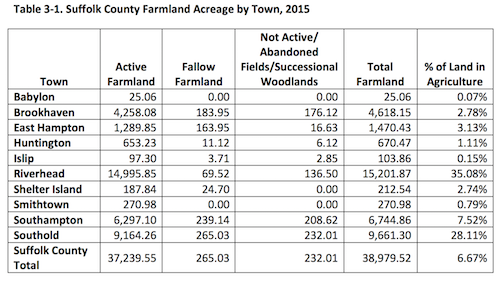Suffolk County has updated its farmland protection program for the first time in 20 years.
The county legislature on Tuesday unanimously adopted the 2015 Suffolk County Agricultural and Farmland Protection Plan, updating a plan last updated in April 1996.
“The plan aims to support adaptable public policy to protect, encourage and sustain agriculture as an industry for future generations in Suffolk County,” according to a press release issued yesterday by Suffolk County Executive Steve Bellone.
“Agriculture in Suffolk County has undergone significant changes over the past 20 years and this updated plan reflects the current state of the industry’s successes and challenges,” Bellone said. The plan will “help ensure that the future of farming in Suffolk is resilient and a productive part of our economy, environment, quality of life, and culture.”
North Fork Legislator Al Krupski, the first farmer ever to serve in the county legislature, said the plan will help the county preserve its deep, fertile soils and build on its past success as a leader in farmland preservation.
“As we face increased threats to food security such as loss of productive farm land and climate change, growing local, nutritious food is vitally important for region, now and into the future,” Krupski said.
In crafting the plan, produced by the county’s Department of Economic Development and Planning, project staff conducted a town by town assessment of the state of agriculture in Suffolk County, where the number of farms and farm acreage has remained “fairly steady” for the past 20 years, stemming a decades-long decline. (Between 1950 and 1992, farmland acreage in Suffolk decreased by 71 percent.)
Suffolk County today has 38,980 acres of farmland — which represents just under 7 percent of its total land mass. Just under half of that acreage is protected.
Nearly two-thirds of the county’s farmland lies in Riverhead and Southold towns, according to the plan: 35 percent of the land in Riverhead Town is farmland, while 28 percent of the land in Southold is farmland. More than half of the farmland in the North Fork towns remains unprotected, and the plan identifies farmland preservation in Riverhead and Southold as its “highes priority.”
“These areas are of great importance because that is where the majority of the remaining farmland is and where the most land with undeveloped prime soils is found. It is important to preserve farmland in these towns to complete the farm belt on the North Fork of Long Island,” the plan states.
The county has created a master list of more than 19,000 parcels of unprotected farmland to be prioritized for preservation and protection.
The plan identifies key challenges to the future success of agriculture in Suffolk. Topping the list: the aging farm operator population and the concomitant “agricultural brain drain” as the next generation pursues other vocations; access to affordable land; extreme weather events and the effects of global climate change; and labor shortages.
It also offers suggested courses of action to help preserve the agricultural industry here, including the continued purchase of development rights to farms that are not yet protected.
Bellone said the plan includes several important additions to its 1996 predecessor, including an increased focus on aquaculture, which has grown in importance within the last decade. Suffolk County ranks first in the state for market value of aquaculture products sold, according to the 2012 U.S. Census of Agriculture. Increases in aquaculture production can be attributed to the Suffolk County Shellfish Aquaculture Lease Program in Peconic Bay and Gardiners Bay, which was adopted by the county in 2009 to lease publicly owned underwater lands to private commercial shell-fishing operations.
Research for the Plan was funded by a $50,000 Farmland Protection Planning Grant from the New York State Department of Agriculture and Markets, a $10,000 grant from the Long Island Community Foundation and an in-kind match from Suffolk County.
Project staff conducted multiple focus groups throughout the county and surveyed local farmers in 2013 to provide public input for the updated plan.
The survival of local journalism depends on your support.
We are a small family-owned operation. You rely on us to stay informed, and we depend on you to make our work possible. Just a few dollars can help us continue to bring this important service to our community.
Support RiverheadLOCAL today.


































